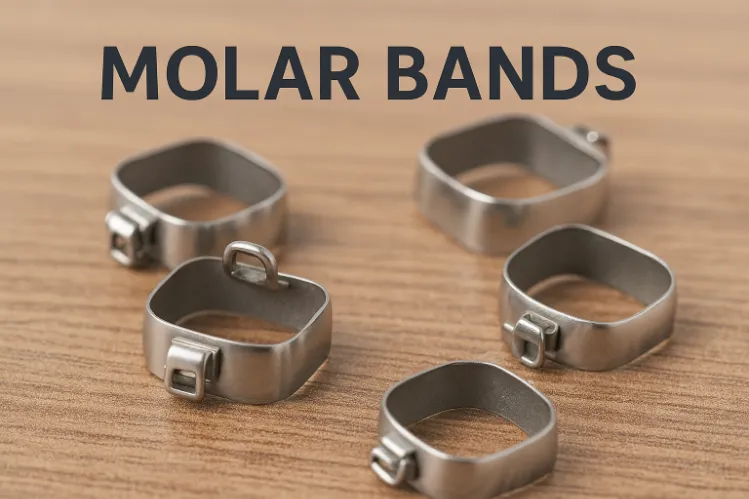
Are you stuffed with so many aligner care tips that now you are just confused about what to do exactly? What's right and what's wrong? If you're stuck in this dilemma, don’t worry – we've got you covered!
Check out our blog to learn dentist-approved tips for maintaining your clear aligners, essential practices to avoid, and extra tips for keeping them.
To keep your clear aligners in top condition and maintain optimal oral health, be sure to follow these easy steps in your daily routine—you’ll notice the difference!

While you're required to wear your aligners for around 22 hours a day, it's essential to store them properly when they're not in use. Instead of leaving them exposed on a table, always place them in a specially designed aligner case.
These cases are built to protect your aligners from airborne bacteria and toxins, reducing the risk of gum infections. They also help your aligners dry between uses, preventing moisture buildup that can lead to bacterial growth.
Another benefit of using the case is that it keeps your aligners safe from pets or children, who might mistake them for toys. This simple yet effective solution ensures your aligners stay clean, secure, and in top condition.

Maintaining your oral hygiene is essential for keeping the aligners clean. Food particles trapped in your teeth can easily transfer onto your aligners, leading to discoloration, foul odors, and plaque buildup. This can eventually cause cavities and mild to severe gum diseases like gingivitis.
Experts recommend brushing your teeth, ideally after every meal, or at least twice a day—after breakfast and before bedtime. When brushing after meals isn’t practical, using an antibacterial mouthwash is a good alternative. Additionally, flossing is highly recommended to clean hard-to-reach areas, ensuring no food particles are left behind.
There are multiple ways to clean your aligners at home that may include:
Whenever you remove your aligners—whether for eating, brushing or any other reason—make sure to rinse them with tap water. This easy step helps eliminate bacteria, plaque, saliva, food debris, and dust, keeping your aligners fresh and clean. It also prevents staining and unpleasant odors from forming.
After cleaning, either wear your aligners again or store them safely in their case. Incorporating this habit into your daily routine will extend the lifespan of your aligners and ensure they remain in optimal condition.
An alternative to specialized aligner cleaning solutions is using a fragrance-free antibacterial soap. Create a diluted solution with the soap, and either rinse the aligners or immerse them in it. The antibacterial agents will help eliminate bacteria, remove buildup, and freshen your aligners by neutralizing odors.
Pro Tips:
Dental cleaning tablets provide an effective and easy-to-use cleaning alternative. Simply dissolve a cleaning tablet in water and allow it to fully dissolve. Then, place your aligners in the solution and let them soak for a few minutes. Afterward, rinse the aligners thoroughly with clean water.
Pro Tip: For the best results, choose dental cleaning tablets that contain ingredients like sodium sulfate.
Vinegar is an effective natural cleaning agent. To make your own aligners cleaning solution at home, take two parts water, add one part vinegar, and stir the solution well. Soak your aligners in this mixture for 10 to 30 minutes, then rinse them with cold water. Your aligners will come out looking clean and fresh!
For tougher stains that don’t come off with a basic rinse, try this easy trick. Make a paste by mixing baking soda with water, creating a gentle scrub. Use either a cotton swab or your regular toothbrush to scrub your aligners. Let the paste sit for at least 15 minutes before rinsing with cold water. You'll be amazed at how clean your aligners will look!
Though cleaning your aligners daily is highly effective, subjecting them to deep cleaning once every week or fortnight can also make a difference. Here are a few ways to deep-clean your aligners:
Invest in ultrasonic cleaners, which are widely available in the market. These devices use specialized ultrasonic waves that create high-frequency bubbles in water. These bubbles effectively loosen dirt, buildup, and stains from your aligners.
Pro Tip: For the best results, always follow the instructions provided in the manual. Be sure to add the recommended cleaning solution to the water and run the cleaner for the exact time specified to achieve optimal results.
Invest in specialized cleaning solutions. These solutions contain agents specifically designed to dissolve plaque and tartar, remove buildup, and eliminate bacteria, thoroughly sterilizing your aligners. For optimal results, simply follow the instructions provided in the product manual. You can use these solutions once a week or every two weeks to keep your aligners in top condition.
Hydrogen peroxide is a widely available product and an excellent disinfectant for cleaning your aligners, helping to sterilize them thoroughly. For best results, create a solution by mixing one part hydrogen peroxide with two parts water.
Let your aligners soak in the solution for about 30 minutes. Afterward, rinse them thoroughly with water to remove any remaining chemicals or lingering taste.
Multiple dental care companies like Caspersmile, offer specialized portable care kits for your aligners. These kits include specialized tools such as chewies to improve aligner fitting, removal tools (especially useful for beginners), a portable storage case, and specialized cleaning solutions. They are sustainable, convenient, and time-saving, making them easy to use and ideal for on-the-go care.
Taking care of your aligners while traveling can be a bit challenging; however, here are some effective traveling care tips:
While cleaning your aligners is crucial, doing it the right way is even more important. Many people clean their aligners regularly but still face issues, often due to common mistakes. To get the best results, here are some things you should avoid:
During lazy days or in the early stages of using your aligners, you might forget or feel too relaxed to take them off. Don’t make this mistake! Eating with the aligners will instantly break them so avoid it at all costs.
Moreover, drinking—especially cold or caffeinated beverages—can stain your aligners and potentially cause damage. Avoid these mistakes to keep your aligners in top condition.
Additional Insight: Avoid eating chewing gums or smoking with the aligners on.
Although it may seem like a good idea to clean your aligners with warm water, it’s actually not! Many people make the mistake of using hot water to wash their aligners, but this can cause the aligners to melt or warp, altering their shape and fit.
If this goes unnoticed, the loose fit can prolong your treatment or negatively impact the final results. Avoid using hot water to keep your aligners in perfect condition.
Not all products available in the market are dentist-approved or safe for your aligners. Regular toothpaste, mouthwash, or harsh home remedies can be too abrasive, leading to scratches and causing your aligners to lose their shine and translucency.
To avoid this, steer clear of unreliable websites and always choose dentist-recommended options. Trusted companies like Caspersmile offer high-quality products designed specifically for aligner care or simply consult a specialist.
Rushing through brushing your aligners or using brushes with harsh bristles can damage them over time. It's best to invest in soft-bristled toothbrushes that provide gentle cleaning while still delivering effective results, helping to preserve the quality and clarity of your aligners.
Taking care of your aligners is essential for very evident reasons including but not limited to:
Aligners are an excellent alternative to traditional braces and can offer exceptional results with the least or no hurdles if taken care of properly. Whether you are new to this journey or are thinking of getting your set of clear aligners, get in touch with Caspersmile to get the best experience in the comfort of your home.


Curated the best for your knowledge
.png) Metallic Taste in Mouth: Causes and How to Get Rid of It
Metallic Taste in Mouth: Causes and How to Get Rid of ItHaving metal taste in the mouth first thing in the morning can be an unexpected experience. You wake up, take a swallow, and suddenly have a metallic taste in your mouth, as if you'd been chewing on a handful of change. It's annoying, a little scary, and sometimes for no apparent reason. For some people, it will be nothing but a minor nuisance; others may fall into the late-night goose chaser. Sometimes it's a sign that there is something wrong with your braces; other times, it could mean that there is something wrong with one of your teeth. But here's the good news: Most metallic tastes are temporary, harmless, and can be treated or resolved. So let's take a closer look at the possibilities.
Read More How Molar Bands Work in Braces and Retainers to Keep Your Teeth in Line
How Molar Bands Work in Braces and Retainers to Keep Your Teeth in LineIf you’ve ever started orthodontic treatment, you already know there are a lot of tiny pieces involved. Wires, brackets, elastics, retainers, attachments… and then there are molar bands. They’re not as famous as braces themselves, but they play a surprisingly big role in keeping your smile moving in the right direction. Some people don’t really notice them. While others desperately want to know why that metal ring is even there. So let’s break it all down: what molar bands are, why orthodontists use them, and how they work in both braces and retainers. Plus, what you should expect throughout the process.
Read More.webp) Dental Bonding Cost: Prices, Process & What to Know
Dental Bonding Cost: Prices, Process & What to KnowIf you’re thinking about fixing a chipped tooth, closing a gap, or smoothing out uneven edges, dental bonding is often the easiest (and quickest) way to do it. And honestly? It’s one of the most budget-friendly cosmetic treatments out there, if you know what to expect. But here’s the part everyone worries about first: “How much does tooth bonding cost?” The short answer: it depends. The long answer: let’s break it all down so you actually understand where the price comes from, what you’re paying for, and whether bonding is the right fix for your smile.
Read MoreQuick Links

Heading